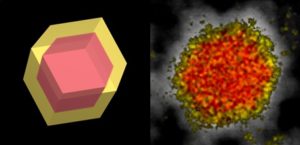
Northwestern investigators have demonstrated that fine-tuning DNA interaction strength can improve colloidal crystal engineering to enhance their use in creating an array of functional nanomaterials, according to a recent study published in ACS Nano.
Chad Mirkin, PhD, professor of Medicine in the Division of Hematology and Oncology, the George B. Rathmann Professor of Chemistry at Northwestern’s Weinberg College of Arts and Sciences, and director of the International Institute for Nanotechnology, was senior author of the study.
Colloidal crystal engineering with DNA involves modifying nanoparticles into programmable atom equivalents, or “PAEs,” which are used to form colloidal crystals that can then be used for designing programmable, synthetic DNA sequences.
Most recently, this process has focused on controlling crystal size and shape, however, even with established methods, it can be difficult to separate crystal formation, or nucleation, and growth.

“New crystals can nucleate throughout the process while existing ones are growing throughout the process, and so you can have some very small crystals that might form late in the process and large ones that are growing the entire time, and you end up with a really non-uniform population in terms of the sizes of the crystals. So, trying to separate those two events, the growth from initial crystal formation, was the problem that we wanted to address,” said Kaitlin Landy, a PhD student in the Department of Chemistry in the Weinberg College of Arts and Sciences and co-lead author of the study.
In the study, Mirkin’s team explored how DNA interaction strength can be used to separate nucleation and growth in colloidal crystallization.
To do this, the team created two groups of complementary nanoparticles: one batch containing complementary base pairs, called “seed” PAEs, and the other containing mismatched base pairs to make “growth” PAEs.

“So, you have your initial crystals [‘seed’ particles] that are forming a solution, and then at a later time your weaker ones [‘growth’ particles] are able to grow on top of what’s already there,” said Kyle Gibson, a postdoctoral fellow in the Mirkin laboratory and a co-lead author of the study.
Using this method, the investigators were able to improve crystal uniformity. They could also independently select the nanoparticle and the DNA shell sequence and essentially mix and match them, allowing them to incorporate different types of materials into the crystals.
“One thing that we think is really powerful moving forward is thinking about how we can track these [crystallization] processes by using different particle cores,” Gibson added.

“This method can be used to make these interesting core-shell structures in a single step, which previously required multiple steps with post-synthetic stabilization of the first crystal before the second growth step,” Landy said. “With these two different DNA interaction strengths, if we can essentially label where the different types of particles are going in the final structure, it’s useful to investigate those fundamental questions.”
Mirkin is also a member of the Robert H. Lurie Comprehensive Cancer Center of Northwestern University.
This material is based upon work supported by the Air Force Office of Scientific Research Award FA9550-17-1-0348 and FA9550-22-1-0300.






